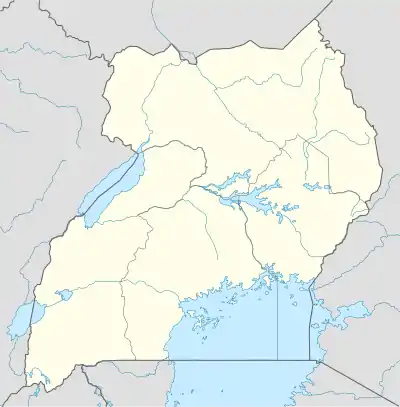Kyaka II Refugee Settlement
Kyaka II Refugee Settlement is a refugee camp in Kyegegwa District in western Uganda.[1]
Kyaka II | |
|---|---|
Refugee Camp | |
 Kyaka II | |
| Coordinates: 0.48°N 31.05°E | |
| Country | |
| Area | |
| • Total | 81.5 km2 (31.5 sq mi) |
| Population (2015)[1] | |
| • Total | 28,175 |
| • Density | 350/km2 (900/sq mi) |
Background
Kyaka II refugee settlement was established in 2005 to receive the remaining population of Kyaka I following the mass repatriation of Rwandan refugees the same year.[2] After this movement, Kyaka I was closed. Around mid-December 2017, renewed violence in DRC - Democratic Republic of Congo led to a new refugee influx into Uganda, with an estimated 17,000 new refugee arrivals in Kyaka II.[2]
Since December 2017, Kyaka II’s refugee population has quadrupled, following the arrival of tens of thousands of refugees from DRC fleeing conflict and inter-ethnic violence in North Kivu and Ituri.[3] There are more than 113,000 refugees already living in the settlement.Kyaka II is managed by the UNHCR and the Ugandan Office of the Prime Minister's Department of Refugees (OPM).[4]
Geography
Kyaka II encompasses 81.5 square kilometres in the three sub counties of Mpara, Kyegegwa and Kabweza in the eponymous Kyaka county. The settlement is divided into nine zones: Sweswe, Buliti, Bukere, Mukondo, Ntababiniga, Kakoni, Bwiriza, Byabakora and Kaborogota.[4]
Health care
Bujiubuli Health Centre III, serves about 141,000 refugees and local Ugandans. This is the main permanent government health facility in Kyaka II, with inpatient and outpatient departments, mental health clinic, nutrition services, HIV/AIDS prevention and care, and a maternity ward. The hospital also offers Ebola and cholera prevention and treatment services which was implemented by the UNHCR with support from the government of Uganda.[5]
Social services
Kyaka II refugee settlement reflects the Ugandan Government’s policy on self-reliance and freedom of movement of refugees, which contrasts to that of nearby Kenya, Malawi and Tanzania. Refugees in settlements in Uganda including Kyaka 2 refugee camp, are given land to build homes and cultivate and food rations are decreased over time (except for those who are considered most vulnerable and in need of sustained support). Refugees are encouraged to engage in income generating from other activities like agriculture and businesses and are free to engage in employment both within and outside the settlement by the opportunities given through the support of the Government of Uganda and other NGOs.[6]
GIZ, an international organization and an implementing body, is also delivering programs in education and health. Other implementing organizations include the Norwegian Refugee Council, Finnish Refugee Council, Right to Play and the Ugandan Red Cross. Refugee Welfare Councils as well as a range of refugee committees and bodies exist at different levels within all 9 zones and 26 villages in Kyaka II and at an overall coordinating role to ensure refugee participation in settlement management and affairs and to contribute to refugee protection for a safe and secure settlement in Kyaka 2 Refugee settlement.
References
- "Uganda". DRC Regional Refugee Response Information Sharing Portal. UNHCR. Retrieved 7 June 2016.
- "Kyaka II Settlement HLP Factsheet 2019". UNHCR Operational Data Portal (ODP). Retrieved 2020-09-23.
- Refugees, United Nations High Commissioner for. "UNHCR takes donors to Kyaka II settlement as flow of DRC refugees continues". UNHCR. Retrieved 2020-09-23.
- Kyaka II Fact Sheet 2014 (Report). UNHCR. 2014. Retrieved 9 June 2016.
- Refugees, United Nations High Commissioner for. "UNHCR takes donors to Kyaka II settlement as flow of DRC refugees continues". UNHCR. Retrieved 2020-09-24.
- "March activities in the Kyaka II refugee settlement (Part 2)". Elrha. Retrieved 2020-09-24.